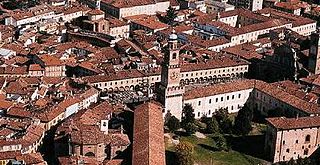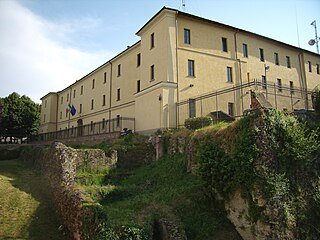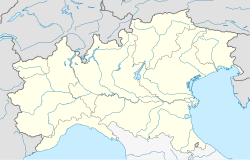
The Visconti of Milan are a noble Italian family. They rose to power in Milan during the Middle Ages where they ruled from 1277 to 1447, initially as Lords then as Dukes, and several collateral branches still exist. The effective founder of the Visconti Lordship of Milan was the Archbishop Ottone, who wrested control of the city from the rival Della Torre family in 1277.
San Genesio ed Uniti is a comune (municipality) in the Province of Pavia in the Italian region Lombardy, located about 25 km south of Milan and about 11 km northeast of Pavia. As of 31 December 2004, it had a population of 3,567 and an area of 9.0 km².

The Civic Museums of Pavia are a number of museums in Pavia, Lombardy, northern Italy. They are housed in the Castello Visconteo, or Visconti Castle, built in 1360 by Galeazzo II Visconti, soon after taking the city, a free city-state until then. The credited architect is Bartolino da Novara. The castle used to be the main residence of the Visconti family, while the political capital of the state was Milan. North of the castle a wide park was enclosed, also including the Certosa of Pavia, founded 1396 according to a vow of Gian Galeazzo Visconti, meant to be a sort of private chapel of the Visconti dynasty. The Battle of Pavia (1525), climax of the Italian Wars, took place inside the castle park.

The Visconti Castle of Pagazzano is a moated, late-medieval castle located in Pagazzano, a town in the Province of Bergamo in the Italian region of Lombardy. The castle in the current form was probably erected between 1450 and 1475, at the initiative of the Visconti di Brignano transforming the previous 14th-century quadrangular fortification with a surrounding moat.

The Castello di Bereguardo is a medieval castle located on Via Castello 2 in the town of Bereguardo, Province of Pavia, region of Lombardy, Italy.

The Visconti Castle in Pandino is a 14th-century castle located in the center of the town of Pandino, province of Cremona, region of Lombardy, Italy. It was built by Bernabò Visconti and his wife, Beatrice Regina della Scala, between 1355 and 1361. Today it essentially retains its original forms.
Mirabello is a suburb of Pavia, Lombardy, northern Italy. It lies north of the city, bordering San Genesio ed Uniti.

The Visconti Castle of Trezzo was a mediaeval castle built between 1370 and 1377 by Bernabò Visconti, Lord of Milan, at Trezzo sull’Adda, Lombardy, Northern Italy. It included a massive tower, 42-meter high, and a fortified bridge on the Adda river on a single arch with a record 72-meter span.

Visconti Park was the private park of the Visconti and Sforza families, lords, and dukes of Milan. Located in Lombardy, northern Italy, it extended between the Pavia Castle and the Pavia Charterhouse. It covered an area of about 2,200 hectares (22 km2) and was encircled by walls about 25 kilometres (16 mi) in length. It was founded in 1360 by Galeazzo II Visconti and enlarged by his son Gian Galeazzo. Its decay began in 1525 with the damages inflicted during the Battle of Pavia. Today, the park's area mainly serves agriculture purposes, while some portions are nature reserves.

The Visconti Castle, or Castello Visconteo, is a castle in the town of Cusago near Milan, Lombardy, Northern Italy. It was built in the 14th century by Bernabò Visconti and used as a hunting lodge by him and other Visconti family members. The castle underwent significant changes in the Renaissance period; today, it is in neglected conditions.

The Visconti Castle of Abbiategrasso is a medieval castle in Abbiategrasso, Lombardy, northern Italy. It was among the first Visconti castles built according to their typical quadrangular layout. In the 14th and 15th centuries, it was one of the preferred residences of the duchesses of Milan of the Visconti and Sforza houses. Today, the castle's surviving part serves as the seat of the municipality of Abbiategrasso.

The Visconti Castle of Binasco is a mediaeval castle located in Binasco, Metropolitan City of Milan, Lombardy, Northern Italy. It is famous for having been the prison and execution place of Beatrice di Tenda, arrested and there sentenced to death for adultery in 1418. Today it is the seat of the Municipality of Binasco.

The Visconti-Sforza Castle is a mediaeval castle located in the centre of the city of Vigevano, Lombardy, Northern Italy. In the 14th and 15th centuries, members of the Visconti and Sforza houses, lords and dukes of Milan, transformed a previous fortification into a vast family resort. The castle was part of a wider plan of urban development for Vigevano, which included the erection of other buildings and the construction of the central Piazza Ducale.

The Visconti Castle or Castello Visconteo of Cassano is a castle of medieval origin in Cassano d'Adda, Lombardy, Northern Italy. It received the current form in the 14th century, when Bernabò Visconti, lord of Milan, enlarged the existing fortification as part of a defensive system of the Visconti dominions on the Adda river. At the end of the 20th century, after a period of abandonment, it was restored and transformed into a hotel.

The Visconti Castle of Lodi is a historical building in Lodi, Lombardy, northern Italy. As it appears today, it is the result of transformations made on a Middle Age castle founded in the 12th century by Frederick Barbarossa. Its name derives from the Visconti family, lords and dukes of Milan, who in the 13th and 14th centuries took possession of and then rebuilt the original fortification.

The Visconti Castle of Legnano is a mediaeval castle, located south of the city of Legnano, Metropolitan City of Milan, Lombardy, northern Italy. It lies on a small island formed by the Olona river. Since the 13th century, it is also known as the castle of San Giorgio.

The Visconti Castle of Voghera is a Middle Age castle in Voghera, Lombardy, Northern Italy. It was built in the 14th century by the Visconti, lords and dukes of Milan.

The Visconti Castle of Jerago is a castle of Middle Age origin located in Jerago, Lombardy, Northern Italy. Having been a property of members of the Visconti house between the 13th and 18th centuries, it retains still today their memory in its name.

The Visconti Castle of Pavia is a medieval castle in Pavia, Lombardy, Northern Italy. It was built after 1360 in a few years by Galeazzo II Visconti, Lord of Milan, and used as a sovereign residence by him and his son Gian Galeazzo, first duke of Milan. Its wide dimensions induced Petrarch, who visited Pavia in the fall of 1365, to call it "an enormous palace in the citadel, a truly remarkable and costly structure". Adjacent to the castle, the Visconti created a vast walled park that reached the Certosa di Pavia, a Carthusian monastery founded in 1396 by the Visconti as well and located about 7 kilometres (4.3 mi) to the north.

The Visconti Rocca of Romano is a rocca in Romano di Lombardia, Bergamo, Lombardy in Northern Italy. It was built in the 13th century and expanded in the 14th and 15th centuries by the Visconti and Colleoni families.





















